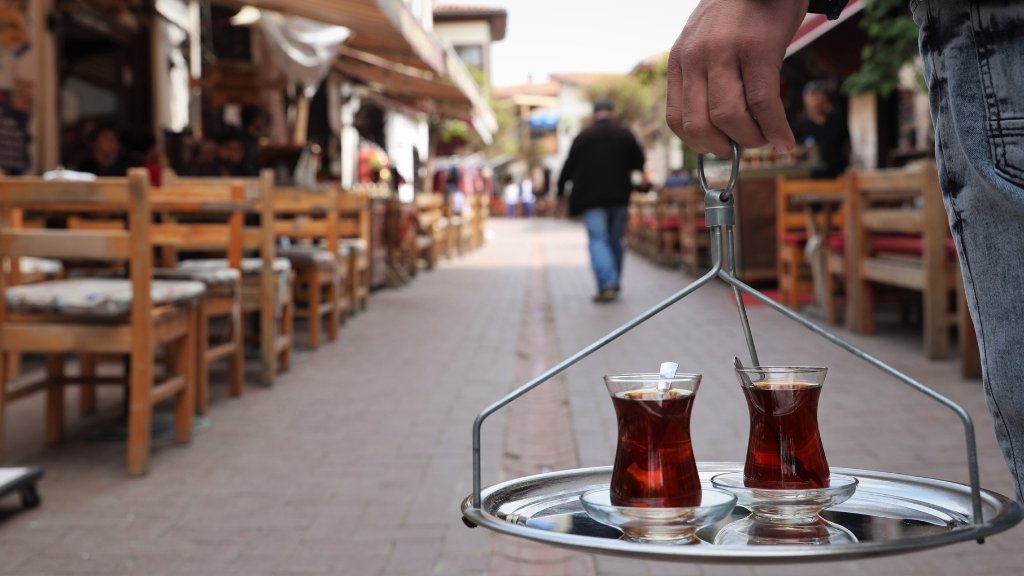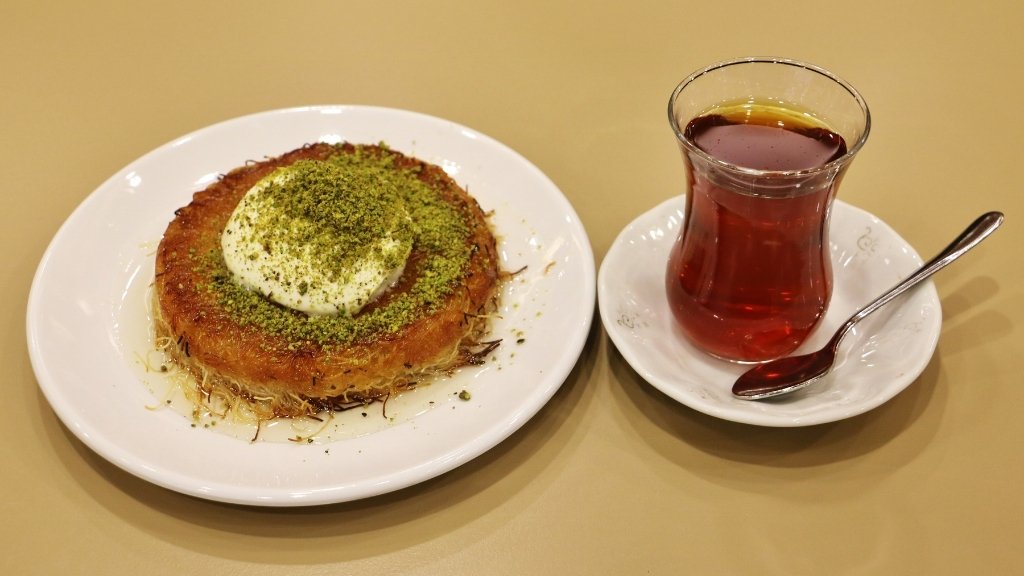From the gentle clink of spoons in tulip-shaped glasses to the rising steam from a freshly brewed çay, Turkish black tea is far more than just a hot beverage—it’s a shared moment, an unspoken invitation to pause. Whether a busy bazaar in Istanbul or a sunset by the Black Sea in Rize, tea is a part of everyday life, served honestly and enjoyed in a chat.
In this guide, we’ll journey through the rich heritage of Turkish tea, learn how to brew it authentically using a çaydanlık, and explore its surprising health benefits. Suppose you have wondered why this dark red tea is so popular, to locals and travelers alike. In that case, you will soon discover why this tea keeps mesmerizing the world one cup at a time.
The Memorable Cup That Changed Everything
On a foggy morning in a hillside village near Rize, I was handed a steaming tulip glass of Turkish black tea by a smiling elder who didn’t speak English—but didn’t need to. The glass felt hot in my hands, and the aroma was comforting and earthy. Around me, locals sat quietly, their fingers wrapped gently around their own glasses of çay, occasionally clinking them in silent agreement. No ordinary cup bore more than tea–a lifelong tradition. I could taste the beat of Turkish tea culture: a language of silence, eye contact, and brewed meaning in that instant.
It was not a drink but a welcome into the world where the connection is brewed gradually, glass by glass.
A Brief History of Turkish Black Tea
The Arrival of Tea in Turkey
The introduction of tea into Turkey was not a new phenomenon, as it had been imported through ancient trade routes, even though it only started to influence the everyday life of Turks in the early 20th century. Perceived as a luxury product, Turkish black tea became popular after it became more affordable and adapted to the local growing conditions. As imports of coffee declined and prices rose, Turks began turning to çay as a more affordable, homegrown alternative, marking the quiet rise of a cultural shift that would forever change their national drink.
The Rise of Çaykur and Rize’s Tea Empire
In the 1940s, the Turkish government launched a major tea cultivation initiative, and the state-run company Çaykur led the charge. With its fertile land and moist climate in Rize, the Eastern Black Sea Region soon became the production center. Nowadays, this coastal province is called the land of Rize tea. It is synonymous with the quality and tradition of Turkish tea culture. Families have depended on this regional identity for generations, making local tea farming a national pride.

Turkish Black Tea plants are growing on the lush, green hillsides of Rize.
How Tea Replaced Coffee in Turkish Homes
When coffee became less and less accessible in the early Republican era, tea replaced it not only in the kitchen but also in customs and associations. You can explore more about how tea gradually replaced coffee in Turkish homes – from ritual to taste to health – in this full side-by-side comparison of both cultural drinks. Turkish tea was the beverage used whenever there was hospitality, at weddings, business discussions, and even in the village, when people met in their quiet chats. Needs became a representation of comfort and belonging, and Turkish tea has become a local custom that is still shaping social life in the country. While Turkish black tea became the daily companion of locals, Turkish Apple Tea emerged later as a sweeter, fruitier version often served to tourists, capturing the essence of hospitality rather than everyday tradition.
👉 If you’re interested in trying it at home, check out our guide on how to make Turkish apple tea for an easy and authentic recipe!
👉 To explore the cultural roots, types, and deeper meaning of Turkish tea, check out this complete guide.
What is so Special about Turkish Tea?
A Stronger Sip Than Most
Compared to normal Western black teas, Turkish tea is significantly stronger and more tannic and has a richer flavor that has a strong ground of its own. It never comes with milk or lemon, and the pure strength and clarity of the brew are allowed to come through. Whether you drink it demli (strong) or açık (light), the focus is always on savoring the unaltered taste – just you, the tea, and the moment.
It’s Black Tea – But Not Just That
Although made from the Camellia sinensis plant, like other black teas, Turkish çay is a distinct category. What makes it special isn’t just the leaf but the brewing ritual using a çaydanlık, a double teapot that gently steeps the tea over time. The result? A deep, complex taste and something that can not be hurried – a long-simmered and communal creation. I’ve learned that this slow process reflects a larger truth in Turkish culture: good things take time.
A Symbol of Connection
Offering tea is a tradition in Turkey and a way to warm the heart. Whether you’re greeted at a village doorstep or pausing at a bustling bazaar, a steaming glass of çay signals warmth, trust, and welcome. I remember hearing a local elder say:
“Tea brews friendships faster than time ever could.”

Traditional serving of Turkish Black Tea in tulip glasses on a street café tray.
It is true. Each cup is not just filled with flavor; it is filled with stories, smiles, and the silent magic of being connected with humans.
How to Make Turkish Çay (The Traditional Way)
The Equipment You Will Require
To brew authentic Turkish tea, you’ll need a çaydanlık—a traditional double-stacked teapot that allows for slow, layered brewing. But if you don’t have a çaydanlık, there are clever ways to make traditional Turkish tea using regular kettles. Use good loose black tea leaves, preferably grown in Rize, which is endowed with rich soil and a suitable climate. It requires fresh, clean water, and boiled water should never be reused because it mutes the flavor.
Step-by-Step Brewing Method
- Boil the Water (Bottom Kettle): Start by filling the bottom kettle of the çaydanlık with water and bringing it to a full boil. This water will steep and dilute.
- Put Tea in the Top Kettle: Put 2 to 3 tablespoons of loose tea leaves in the upper kettle (no tea bags, please, as they will interfere with the richness of the flavor).
- Add Water & Start Steeping: When the bottom of the pot is boiling, pour some hot water into the leaves in the top kettle. Steep it slowly, but leave the rest of the water hot in the bottom pot.
- Steep Gently to Taste: Steep the tea between 15 and 20 minutes. Do not overheat, as this will make it bitter. During this period, the tea becomes concentrated.
- Pour and Adjust Strength: Pour a small amount of the concentrated brew into a tulip glass, then add hot water from the bottom pot. It will rely on your taste.
Demli (Strong) = More Concentrate
Açık (Light) = More Water
For a more hands-on brewing walkthrough with insider tips and tea ratios, you can check our complete guide on how to make Turkish tea the way locals do—steeped in tradition and perfected with every cup.
Serving Etiquette: Pure, Simple, and Shared
Never put Turkish Tea in a cup, but in a tulip glass because it is clear, reddish, and hot for so long. Sugar cubes are served on the side, but milk will never be added; it takes away the natural richness of the black tea. Whether you’re in a home or café, this small glass is more than a drink—it’s a social gesture, an invitation to pause and connect.

Turkish Black Tea served with traditional künefe dessert, topped with pistachios.
Health Benefits of Turkish Black Tea
Powerful Source of Antioxidants
Turkish tea is rich in natural antioxidants, particularly theaflavins and catechins, which help counter inflammation and support heart health. Such compounds enhance circulation, decrease blood pressure, and prevent chronic conditions. I also tend to find that only a few cups a day make me feel refreshed—I do not require supplements.
Natural Mental Boost Without the Crash
Turkish black tea has approximately 40mg-60mg of caffeine in a cup, and it provides a smooth and sustained boost in mental alertness. It is ideal for people who want concentration but do not wish to feel anxious, as can happen when using coffee. I tend to grab something warm (a glass) in the afternoon when I am writing—this keeps me alert but not jumpy.
Soothing for Digestion
After a meal, one of the best moments to drink Turkish tea is when the natural tannins and low caffeine aid digestion, especially when you have eaten a heavy or oily meal. It is popular in most Turkish families to offer tea after lunch or dinner as a sign of hospitality and because it helps. At least, it reduces bloating and discomfort.
Be Mindful of Overconsumption
Although Turkish black tea is less harsh than coffee, consuming over six cups a day affects the absorption of iron, particularly in individuals who are already iron-deficient. To avoid any side effects, try pairing your tea with iron-rich foods or enjoy it between meals, and if you’re curious, then check out our full guide on the benefits and side effects of Turkish tea.
Cultural Rituals & Daily Tea Life in Turkey
The Tea House (Çay Bahçesi) Experience
Walking into a çay bahçesi (tea garden) in Turkey is like stepping into the heart of the community. These neighborhood tea houses are not only where you come to drink Turkish tea; they are open-air theaters of friendship, stories, and the game of backgammon, which can turn into theatrical performances. It could be a silent beach garden in Rize or a busy square in Istanbul. Still, you will see people sitting there for hours, laughing, discussing politics, or just constantly admiring the view with tea refills.
In the afternoons, I have sat in these places where one drink becomes four, and no one is in a hurry.
Tea at the Heart of Social Life
Whether at weddings, holidays, casual visits at home, or business meetings, Turkish tea is always present. It is a drink and a warm welcome to anyone who has it as a sign of friendship. Its importance isn’t just in the brewing – it’s deeply tied to tradition, comfort, and identity in everyday Turkish life. I have witnessed negotiations made and family arguments smoothed over a hot tulip glass.
Tea connects people across generations and social classes and makes everyone feel that they belong to something familiar and comfortable.
The Unspoken Rules of Turkish Tea Etiquette
The way you take your tea is as important as tea in Turkey. There is no one to speak aloud about these silent traditions, but these silent traditions have a lot to say:
- Never Rush Tea Time: Tea is meant to be savored, not rushed. It is a break during the day—a time to think, to communicate, or simply to be there.
- Always Offer Refills: Hospitality is sacred. When a person has finished their glass, it is considered a norm to offer another, sometimes even without being asked. This is a sign of a full tray of glasses to be refilled, a sign of warmth and good manners.
- Drinking Together Means Bonding: Sharing Turkish tea isn’t just about thirst. It is a symbolic gesture of bonding, trust, and respect—whether with a friend, a stranger, or a client.
What Turkish Tea Means to Me
“As a person living in Turkey for more than 10 years and in the world of rich Turkish cuisine, I soon understood that Turkish tea is not a simple drink; it is the tradition that lives there. Whether it is the morning routine or late night conversations, this humble beverage runs through all layers of our everyday lives, connecting people with one another by creating moments and memories.”
Miral Fatima – Cultural Food Storyteller & Ritual Explorer
FAQs About Turkish Black Tea
Is Black Tea the same as Turkish tea?
On the one hand, yes, Turkish tea is black, but it is not served in a regular cup. It is made in a çaydanlik (a double teapot), poured in layers of strength, and never served with milk, which releases its strong, earthy flavor that is deeply ingrained into Turkish culture.
How is Turkish Tea different from British Tea?
British tea is normally milder, mixed with other leaves, and served with milk or lemon, but Turkish tea is stronger, not mixed with other leaves, and never with milk. Turkish tea is intended to be taken leisurely—usually in conversation or thought—so it has a different social pace from the British afternoon tea ceremony.
Can I use tea bags instead of loose tea?
Technically, yes, but you will be missing out on the richness that loose-leaf Turkish tea offers. The Rize leaves, e.g., provide an intense aroma and color that can never be matched by tea bags. I have tried them both, and believe me, you just never go back to loose after you have tried it.
What’s the proper way to drink Turkish Tea?
It is never drunk in any other glass but a tulip glass–warm and to be drunk slowly. You can add sugar cubes to it if you want it sweet, but no milk is allowed. Turkish tea is not a drink; it is an existence. A ceremony of leisurely quaffing, warm hands on the glass, moments in silence with one another or alone.
Does Turkish tea have more caffeine than Green tea?
Sure, it has more caffeine than green tea, but it has much less than an average cup of coffee. It provides enough of a mental boost without the jitters, which I adore in the middle of the afternoon break.
Final Thoughts
Turkish black tea is not a drink you taste but an experience. It is not a drink but a silent ceremony that binds generations, memories, and ordinary moments. From the gentle steeping in a çaydanlık to the warmth of a tulip glass cradled in your hands, every step invites you to pause and connect. Whether served in a crowded teahouse or in the quiet of your house, each cup means hospitality, patience, and presence. Slow it all down, allow the fragrance to ascend, and discover how this starts with Turkish tea, culture, comfort, and conversation.
If you love the soulful heat of Turkish çay but want something cooler for the summer, try our Turkish Iced Tea guide – it’s the same rich flavor with a refreshing twist.

Hi, I’m the heart behind Turkish Aura. I lived in Turkey for 10 beautiful years, where I fell in love with its tea, traditions, and soulful way of life. This blog is my way of sharing real stories, cultural wisdom, and personal experiences to help you feel the true essence of Turkish culture – just like I did.Thank you for being here, and love you!



